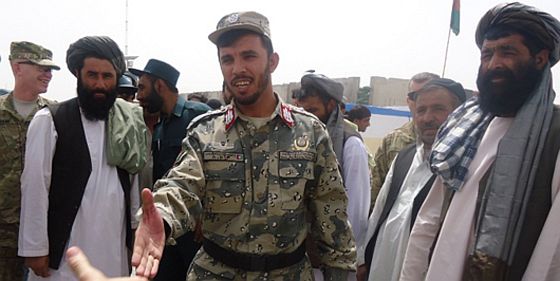What’s the difference between the death squads being operated by the Haqqani network and the night raids by US Special Operations forces? Chances are that the Haqqanis know the names of a much higher percentage of their victims. That isn’t the only difference, but it’s significant. As far as the U.S. and its allies are concerned, any adult male who gets shot in the night by their forces gets counted as an insurgent.
The New York Times reports: As targeted killings have risen sharply across Afghanistan, American and Afghan officials believe that many are the work of counterintelligence units of the Haqqani militant network and Al Qaeda, charged with killing suspected informants and terrorizing the populace on both sides of the Afghanistan-Pakistan border.
Military intelligence officials say that the units essentially act as death squads and that one of them, a large group known as the Khurasan that operates primarily in Pakistan’s tribal areas, has been responsible for at least 250 assassinations and public executions.
Another group, whose name is not known, works mainly in Afghanistan and may be responsible for at least 20 killings in Khost Province over the summer alone, including a mass beheading that came to light only after a video was found in the possession of a captured insurgent. The video shows 10 headless bodies evenly spaced along a paved road, while their heads sit nearby in a semicircle, their faces clearly visible.
It is another indication that the Haqqanis, a mostly Pakistan-based faction, remain the most dangerous part of an insurgency that makes full use of a porous and often ill-defined border, as the NATO strike that killed 24 Pakistani soldiers over the weekend showed.
Though the circumstances of that strike remain murky, it has now further upset relations between Pakistan and the United States, even as it once again demonstrated how havens inside Pakistan remained a critical part of the insurgent strategy.
The Americans have geared their offensive around bloodying the insurgents as they enter Afghanistan. But the new wave of assassinations shows that, even as NATO portrays the insurgents as a weakening force, the Haqqanis can still assert their influence, not only with headline-grabbing bombings but also through intimidation and by controlling perceptions.
One chilling case attributed to the second death squad came after American forces captured the senior Afghanistan-based leader for the Haqqanis, Hajji Mali Khan, and killed his top deputy this summer. Just days later, the bodies of two men accused of helping the Americans turned up near the village where Mr. Khan was captured. Scalding iron rods had been shoved through their legs. One victim had been disemboweled, and both had been shot through the head and crushed by boulders. Fear shot through the entire village.
“You could hardly recognize them,” said a witness who viewed the bodies.
Across Afghanistan, assassinations have jumped 61 percent, to 131 reported killings, through the first nine months of this year, compared with the same period in 2010, according to NATO statistics. United Nations officials say they began noticing a sharp increase in 2010, with 462 assassinations according to their records, double the number from the previous year. The figures may not include many killings in remote areas, like the mass beheading, because fearful villagers never reported them.
Early this month, Gareth Porter wrote: U.S. Special Operations Forces (SOF) killed well over 1,500 civilians in night raids in less than 10 months in 2010 and early 2011, analysis of official statistics on the raids released by the U.S.-NATO command reveals.
That number would make U.S. night raids by far the largest cause of civilian casualties in the war in Afghanistan. The report by the U.N. Assistance Mission in Afghanistan on civilian casualties in 2010 had said the use of Improvised Explosive Devices (IEDs) by insurgents was the leading cause of civilian deaths, with 904.
Except for a relatively few women and children killed by accident, the civilians who died in the raids were all adult males who were counted as insurgents in press releases and official data released by the International Security Assistance Force (ISAF).
The data on night raids, which were given to selected news media, cover three distinct 90-day night raid campaigns from May through July 2010, early August to early November, and mid-November to mid- February. The combined totals for the three periods indicate that a minimum of 2,599 rank and file insurgents were killed and an additional 723 “leaders” killed or captured in raids.
Assuming conservatively that one-third of the alleged leaders were killed, the total number of alleged insurgents killed in the raids was 2,844.
SOF night raids during the 10-month period totaled 6,282, according to the same ISAF data.
A third crucial statistic, repeated frequently by U.S and NATO officials in 2010 and 2011, is that shots were fired by SOF units in only 20 percent of night raids.
A U.S. military source who has been briefed on SOF operation confirmed to IPS what has been generally known among outside observers – that anytime shots are fired by SOF troops in a night raid, someone is killed.
If shots were fired in 20 percent of the 6,282 raids, it means that 2,844 were killed in 1,256 raids.
With very rare exceptions, night raids target only individuals rather than groups. They are carried out at night because they are aimed at catching the individual at home asleep and therefore taken completely by surprise.
Therefore, a minimum of 1,588 people (2,844 total killed minus the 1,256 targets in the lethal raids) were killed in the raids even though they weren’t targeted.

